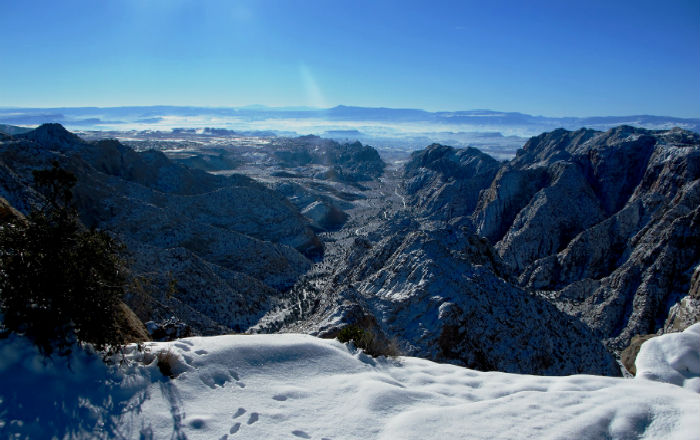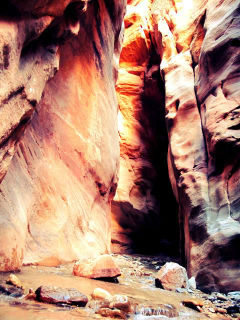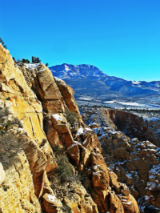Looking back a year: Red Mountain Trail in the Snow and when Desert Rats Become Snow Bunnies
 Written by Greta Hyland
Written by Greta HylandAn early Mormon settler visiting St. George from Salt Lake once asserted that if he had to choose between a house in St. George in August and one in hell, he’d choose hell. While Southern Utah is known for its heat and warm weather recreation, and though many enjoy the cool reprieve winter provides, most desert rats and snowbirds find hell an enviable alternative to winter. Even for residents who enjoy winter sports, most like choosing when and for how long they experience the snow. So when snowmageddon descended last year, many looked on with dismay as their temperate weather and year-round recreation come to a freezing halt. Still, though, a small part of the population here was thrilled to explore the unique recreational opportunities in the newly transformed desert.
The first hint of winter appeared in September when an early cold front rolled in to the southwest. It was still warm when we first made plans to hike Kanarraville Falls and what would be the last canyon of the summer, but when that day arrived it was a surprisingly chilly 62 degrees. Heading up the trail we joked about the yearly fall tease that always turns back to summer. But once we stepped into the cold water and shadows from the enclosing mountains, we began to doubt whether summer would return.
 The canyon walls flickered in the mercurial sunlight like a candle disturbed by a restless breeze. Trees and shrubs burst into vibrant colors of red and yellow against the increasing shadows. It was spectacular. Temperatures also continued to drop, so we cut out shortly after reaching the waterfalls at the end of the slot canyon and chased the waning sunlight back through the canyon struggling to stay warm. As we emerged from the canyon, dark purple clouds hung on Pine Valley Mountain to the west, overtaking the sun that was illuminating great swaths of land before finally blinking out. Winter was in the air. We hurried to our cars in a veil of twilight, invigorated by the brisk hike and rapidly changing forecast. As we warmed our cold feet, a voice on the radio alerted listeners to a freeze warning for all of southern Utah.
The canyon walls flickered in the mercurial sunlight like a candle disturbed by a restless breeze. Trees and shrubs burst into vibrant colors of red and yellow against the increasing shadows. It was spectacular. Temperatures also continued to drop, so we cut out shortly after reaching the waterfalls at the end of the slot canyon and chased the waning sunlight back through the canyon struggling to stay warm. As we emerged from the canyon, dark purple clouds hung on Pine Valley Mountain to the west, overtaking the sun that was illuminating great swaths of land before finally blinking out. Winter was in the air. We hurried to our cars in a veil of twilight, invigorated by the brisk hike and rapidly changing forecast. As we warmed our cold feet, a voice on the radio alerted listeners to a freeze warning for all of southern Utah.
The unusual weather led many to predict a bitter winter, but cold in the desert is relative and most believed it would still be mild compared to the north. Soon after Thanksgiving, however, and contrary to hopeful thinking, a blistering cold front reminiscent of more northerly climes blew in and dropped 8 to 14 inches of snow. Temperatures fell below freezing for over a week, and county roads remained unplowed as residents were left to navigate the wintry conditions at their own risk if they chose not to heed warnings to stay home. Even church was cancelled.
The desert seemed to literally freeze into a bluish-white landscape overnight. According to historic weather data, a record breaking winter hits southern Utah roughly every 40 years. While many experiencing this rare treat find it to be anything but, there are some who looked forward to the promise of snowy adventures with glee, and jumped at the chance to strap on some Yaktrax, crampons, snowshoes, or skis and play in the snow locally.
Snow amplifies the alluring qualities of solitude and peace found in the desert: places normally bustling with tourists and crowds become serenely quiet and still; wildlife can be heard, and traces of their presence are more easily seen; and canyons that are normally familiar transform into wintry and unfamiliar versions of themselves. Exploring the desert during the winter is much like getting out into the back country, whether you are really in the back country or not. Winter may just be the best time of year to visit the desert, but if you really want a rare experience, visit after a record breaking snowstorm. The best part? You get to explore the dramatically changed landscape as if for the first time.
Snow Canyon, considered by many to be a geologic paradox waiting to be explored, could not be more inviting and inspire more awe than when snow accentuates all the ripples and folds of the canyon features. Usually swarming with people seeking the hidden canyons and humbling views beneath the vertical walls, it empties quickly when temperatures drop significantly, leaving an abundance of opportunities to enjoy the canyon. Because most of the trails are sandy and not too steep, they can be hiked as easily during winter as in warmer seasons, and even the steeper and rockier hikes can be done with very little gear.
One winter favorite is Snow Canyon Overlook. It’s always a chilly hike in December, but last year it was not just a cold and snowy trek, it offered a spectacular wintry vista. The trail starts outside of Snow Canyon off highway 18 near the southern end of Dammeron Valley, and ends at the northern tip of Snow Canyon. It provides a view of the entire canyon all the way out to the Arizona Strip, that when covered with snow, looks like a chute blazed by Boreas and his stampeding wintry hordes.
 Though for us Snow Canyon is always a place of Christmas ritual, we had to get out and explore it while covered in snow. It was spectacular inside the park, but we wanted a panoramic view from the top. So not waiting until Christmas Eve as usual, we excitedly stuck out while the temperatures were still low and the snow was deep. The two mile hike to the overlook, untouched except for a solitary pair of footprints, sparkled in the sun and was barely recognizable as it wound through trees and over slick rock.
Though for us Snow Canyon is always a place of Christmas ritual, we had to get out and explore it while covered in snow. It was spectacular inside the park, but we wanted a panoramic view from the top. So not waiting until Christmas Eve as usual, we excitedly stuck out while the temperatures were still low and the snow was deep. The two mile hike to the overlook, untouched except for a solitary pair of footprints, sparkled in the sun and was barely recognizable as it wound through trees and over slick rock.
The outcrop at the overlook was peacefully quiet and serene, more magnificent than we had ever seen it. The whole world looked fragile, crystalized, as if a whistle could shatter it. Looking out at the frosty mountains and white desert expanse we kicked ourselves for not coming prepared with a thermos of coffee to enjoy with the view. Without a way to keep warm in the frigid temperatures, we snapped some photos and turned back. Rejuvenated by the exposure and invigorated by the physical activity, we headed for our second favorite winter pastime: drinking coffee.
With warm cups of coffee in our hands, thawing us from the inside out, we looked through our photos and marveled at how different southern Utah looked. Even though we had seen it with our own eyes, it was still hard to believe. Cold in the desert is shocking because the mind does not easily put the two together, but the chance of experiencing it during a rare 40 year storm is fantasy-like. Donning cold weather gear, seeing our breath puff lightly in the cold air, and the promise of warmth that home and hearth provide from a cold winter outing is a gift the desert rarely provides. Even those who prefer the heat can’t help getting caught up in the excitement that winter brings, however briefly it may stay. It is a time to relish and enjoy because soon enough the heat will return and claim its rightful place here in the desert. And luckily for all you snowbirds and desert rats who hate the cold, it will probably be business as usual this year. But it’s still fun looking back and reminiscing about snowmageddon 2013.
 Greta Hyland has a Masters degree in Environmental Policy & Management and has worked for the BLM and the NPS as well as for non-profit organizations. She is a regular contributor to the Utah Adventure Journal and is the Copy Editor at the Independent. She writes regularly on her blog about environmental policy issues affecting the southwest, as well as personal narratives about outdoor recreation and simple living. Her blog can be found at www.thesouthwestjournal.wordpress.com A Utah native, Greta is a consummate desert rat and loves exploring the southwest. She can be reached at [email protected].
Greta Hyland has a Masters degree in Environmental Policy & Management and has worked for the BLM and the NPS as well as for non-profit organizations. She is a regular contributor to the Utah Adventure Journal and is the Copy Editor at the Independent. She writes regularly on her blog about environmental policy issues affecting the southwest, as well as personal narratives about outdoor recreation and simple living. Her blog can be found at www.thesouthwestjournal.wordpress.com A Utah native, Greta is a consummate desert rat and loves exploring the southwest. She can be reached at [email protected].
Follow The Independent: Facebook Google+ Twitter Instagram Tumblr




